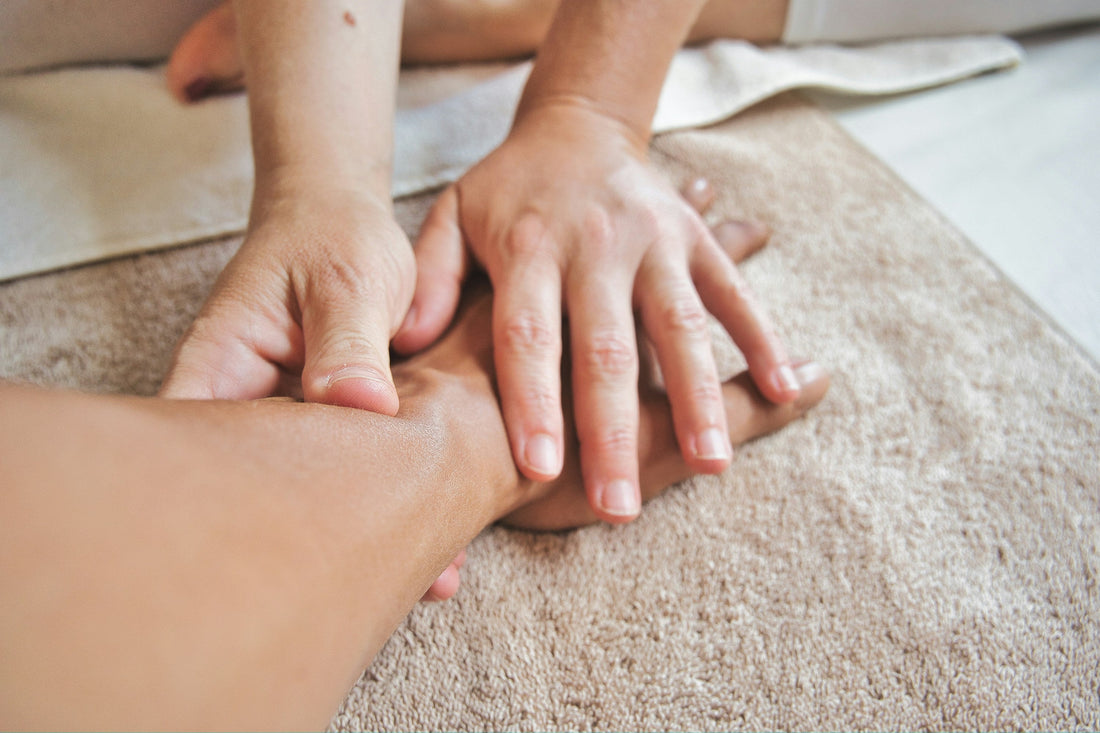
The Science Behind Massage Therapy in Recovery
Share
The Role of Massage Therapy in Addiction Treatment
Massage therapy is more than just a luxury—it’s an evidence-based modality increasingly integrated into addiction treatment and rehab programs. As recovery approaches become more holistic, the role of massage therapy has expanded to support not only physical healing but also emotional regulation and stress reduction.
For people in drug rehab or those struggling with addiction, massage therapy can help manage pain and discomfort, promote relaxation, and ease symptoms in the early stages of withdrawal. When combined with talk therapy, medication, and self-care, it becomes a powerful complementary approach to improving well-being throughout the recovery process.
Scientific Benefits of Massage Therapy for Recovery
The benefits of massage therapy in recovery are supported by growing research in physiology, psychology, and addiction medicine.
1. Reduces Cortisol and Enhances Serotonin/Dopamine Production
Massage helps lower the stress hormone cortisol, which is often elevated in people undergoing addiction treatment or detoxification. High cortisol levels can weaken the immune system, disrupt sleep, and trigger anxiety—factors that contribute to relapse.
Simultaneously, massage stimulates the production of serotonin and dopamine, two feel-good neurotransmitters. People who’ve turned to drugs or alcohol often have imbalanced neurochemistry. Therapeutic massage helps rebalance these systems, improving mood and emotional resilience.
2. Improves Sleep and Reduces Anxiety
Massage therapy clients often report better quality of sleep and reduced stress and anxiety. As part of a recovery plan, better sleep supports the brain's ability to heal, enhances decision-making, and increases motivation to stay sober.
3. Increases Blood Flow and Supports Detoxification
Kneading, pressure, and movement used in massage stimulate blood flow, aiding the removal of toxins from muscle tissues and boosting the body’s immune system. Enhanced circulation also reduces pain and discomfort, making it easier for clients to engage in other treatments or an exercise program.
4. Alleviates Chronic Pain and Physical Tension
Many individuals in rehab experience chronic pain, whether due to sports injuries, postural stress, or the physical toll of substance use. Massage therapy also helps treat conditions such as chronic low back pain, headaches, and muscle stiffness—without relying on medication, which is especially important in drug and alcohol treatment programs.
How Massage Therapy Helps Reduce Stress and Relapse Risk
One of the most valuable outcomes of massage therapy in recovery is its ability to reduce the likelihood of relapse. Here’s how therapy helps support ongoing sobriety:
- Self-awareness and emotional regulation: Touch-based therapies encourage clients to reconnect with their bodies, promoting self-awareness—a critical part of addiction recovery. This awareness can help individuals recognize emotional or physical relapse triggers.
- Stress relief without substances: By providing a feel-good experience and deep relaxation, massage therapy offers a non-drug source of pleasure and calm, which is crucial for those recovering from substance abuse.
- Stabilization of mood: Regular sessions help regulate emotions and support the development of healthy routines—replacing the chaos of addiction with healing structure.
Connection to the Vagus Nerve
Massage activates the vagus nerve, which controls parasympathetic nervous system responses. This activation slows the heart rate, deepens breathing, and promotes calm—all essential for clients navigating addiction treatment or outpatient programs.
Massage Therapy Modalities Used in Rehab Settings
Many rehab centers now offer different types of massage therapy as part of an integrative treatment model. Each approach targets specific symptoms or conditions related to addiction, withdrawal, or co-occurring health issues.
1. Swedish Massage
- Gentle, flowing strokes to promote relaxation
- Enhances mood and reduces anxiety
- Ideal for clients new to massage or in early stages of withdrawal
2. Deep Tissue Massage
- Targets deeper muscle layers and connective tissue
- Helps relieve chronic pain, tension, and physical trauma
- Common among clients with sports injuries or persistent pain and discomfort
3. Myofascial Release
- Focuses on releasing tension in the fascia (the connective tissue)
- Supports mobility and posture
- Beneficial for clients experiencing stiffness or body-based anxiety
4. Shiatsu and Acupressure
- Based on Traditional Chinese Medicine principles
- Balances energy flow and promotes emotional harmony
- Complements treatments like acupuncture and talk therapy
5. Trigger Point Massage
- Targets specific knots or “trigger points” in muscles
- Effective for pain related to tension headaches, back pain, or postural strain
- Often used in conjunction with physical therapy
Each form of massage is designed to help clients heal without reliance on medications, making it an ideal option in drug rehab and substance abuse recovery centers.
Massage and the Mind-Body Connection in Holistic Recovery
The holistic model of addiction recovery acknowledges the interconnectedness of the body’s physical, emotional, and psychological systems. Massage therapy plays a vital role in reinforcing that connection.
Supporting Self-Care and Self-Compassion
Massage therapy also supports clients in reclaiming ownership of their body and healing from trauma—common experiences among those in addiction treatment. This embodied healing encourages self-care, rebuilding the body as a safe and trustworthy place.
Complements Other Treatment Modalities
In rehab settings, massage doesn’t replace other therapies, but it complements them:
- Talk therapy addresses thoughts and behaviors
- Group therapy builds social support
- Nutritional counseling restores physical wellness
- Massage therapy relieves somatic tension and improves cortisol levels
When these therapies work together, clients receive more balanced, sustainable support.
When to Integrate Massage into a Recovery Plan
Massage typically becomes most useful in the post-acute withdrawal phase, when the body begins healing and the client is more receptive to touch and relaxation.
However, depending on the client's physical and emotional state, massage may also be helpful:
- During detox, to reduce agitation and improve sleep
- After exercise programs, to ease soreness and support fitness goals
- For long-term maintenance, as part of routine self-care
- In outpatient treatment, to reduce the daily stress of maintaining sobriety
Best Practices for Introducing Massage in Treatment:
- Ensure clients feel safe and consent to touch
- Coordinate with clinicians to integrate massage with medical or psychological care
- Start with short, gentle sessions to avoid overstimulation
- Use licensed, trauma-informed massage therapists
Research Supporting the Role of Massage in Addiction Recovery
Scientific literature continues to support the inclusion of massage therapy in treatment programs for individuals with substance abuse issues.
- A 2010 study published in Substance Use & Misuse found that participants who received massage therapy during residential rehab had significantly lower anxiety levels and improved mood.
- A 2021 article in the Journal of Alternative and Complementary Medicine reported that massage therapy can help regulate heart rate variability, a key biomarker for stress resilience and relapse prevention.
- Research also shows that regular massage therapy sessions can reduce chronic pain, support the body’s immune system, and promote hormonal balance.
These studies affirm what many treatment providers observe: massage therapy helps people feel better—faster, deeper, and with fewer side effects than many conventional pain interventions.
Final Thoughts: Massage Therapy as a Tool for Long-Term Recovery
Integrating massage therapy into a holistic recovery plan offers several benefits—from lowering stress and reducing cravings to managing chronic pain and improving mood. While it is not a standalone cure, massage can help reinforce the goals of addiction treatment by promoting physical and emotional healing.
In drug rehab settings, where many people are navigating the aftermath of drug or alcohol use, massage therapy serves as a gentle, restorative intervention that brings balance to the recovery process. It reminds clients that they can feel good without their drug of choice, helping them regain trust in their bodies and resilience in their minds.
For those in outpatient, residential, or integrated treatment programs, receiving massage regularly can become a key element of lasting recovery—supporting better quality of sleep, increased self-awareness, and reduced risk of relapse.
Key Takeaways
- Massage therapy can help regulate stress, support detoxification, and reduce pain in recovery.
- It complements medical, psychological, and behavioral therapies in addiction treatment.
- Popular modalities include Swedish, deep tissue, myofascial, and Shiatsu.
- Scientific studies support massage's impact on cortisol levels, dopamine, serotonin, and immune function.
- Massage therapy is especially effective as part of a holistic approach to drug rehab and substance abuse treatment.
FAQs About Massage Therapy in Addiction Recovery
How does massage therapy help in addiction treatment?
Massage therapy helps reduce stress, ease withdrawal symptoms, and promote emotional regulation. It lowers cortisol levels (the stress hormone) and increases serotonin and dopamine, supporting mood balance and relaxation—both essential in addiction treatment and relapse prevention.
Can massage therapy reduce the risk of relapse?
Yes. Regular massage therapy sessions promote self-awareness, lower anxiety, and provide a non-drug-related source of comfort and well-being. These effects help reduce emotional triggers and cravings, which are major contributors to relapse.
Is massage therapy safe during withdrawal?
In many cases, yes—particularly during the post-acute withdrawal phase. However, it’s important that massage therapists are trained to work with clients in recovery. Always consult a medical provider before starting massage during detox, especially if withdrawal symptoms are severe.
What types of massage are used in rehab settings?
Common forms of massage used in drug rehab and treatment programs include:
- Swedish massage for general relaxation
- Deep tissue for chronic pain and muscle tension
- Myofascial release to improve mobility
- Shiatsu or acupressure for emotional and energy balance
Each type supports the recovery process in different ways depending on the client’s needs.
How often should someone in recovery receive massage therapy?
This depends on individual needs, but massage typically shows the most benefit when done weekly or biweekly, especially during the first 3–6 months of recovery. As part of a holistic recovery plan, it can also be used on an ongoing basis for stress management and physical support.
Can massage therapy replace other addiction treatments?
No. While massage therapy offers many benefits, it should always be used as a complementary treatment, not a replacement. It works best when combined with talk therapy, medical care, support groups, and lifestyle changes as part of a comprehensive treatment program.
Is massage therapy helpful for co-occurring issues like anxiety or chronic pain?
Absolutely. Massage therapy also helps manage conditions like chronic low back pain, insomnia, anxiety, and pain and discomfort from sports injuries—which often co-occur with substance abuse. Managing these issues can support long-term sobriety.
